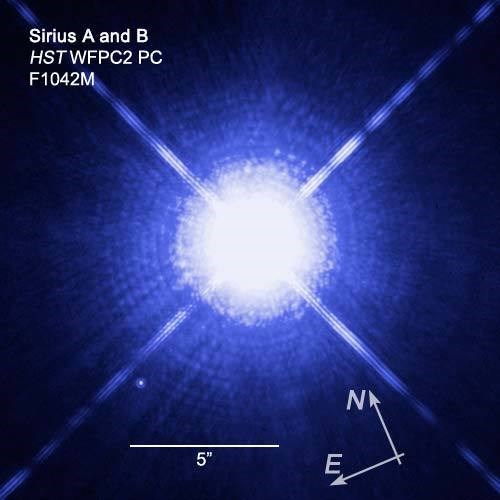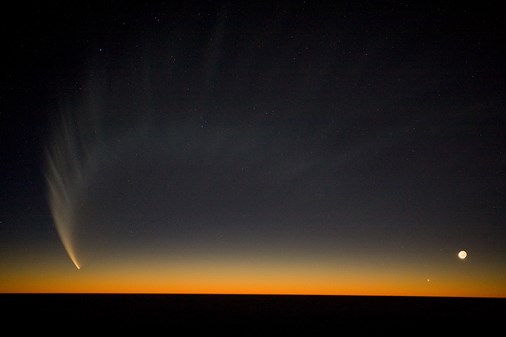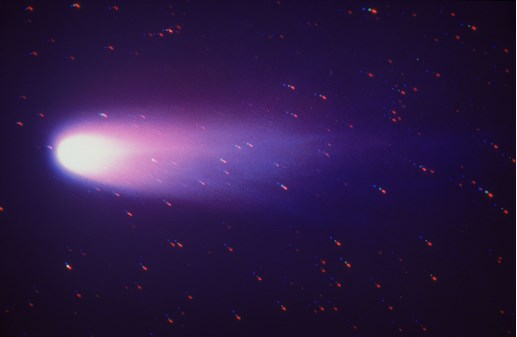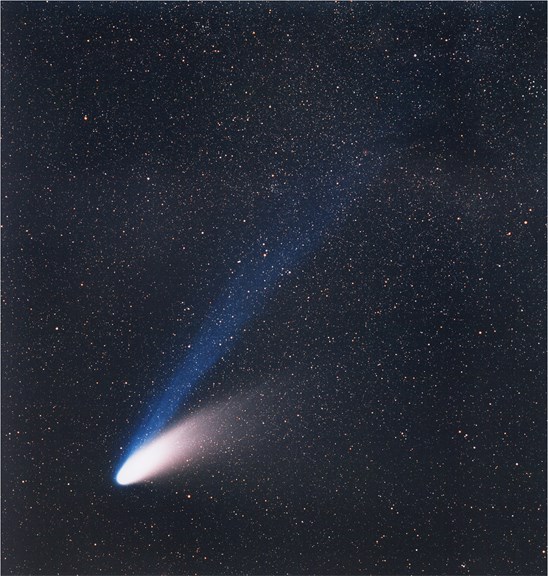Skynotes: February 2023
Upcoming events
Comet ZTF in our skies
If you are lucky enough to be under dark country skies between 6 – 14 February, there’s a chance you’ll see Comet ZTF (C/2022E3). But don’t expect anything too spectacular, as the comet will only just be bright enough to be seen with the naked eye.
It will be in the northern sky between 10-11pm and to our eyes it will appear as a small fuzzy blob, while binoculars or telescopes can reveal much more. Comet ZTF was last near Earth 50,000 years ago. It comes from a reservoir of comets known as the Oort Cloud that exists in the outermost reaches of the Solar System.
There are over 3,700 known comets. At any time there can be dozens of comets in the sky but it’s only on the rare occasions when a comet becomes bright enough to be visible that they are widely publicised. And while the position of a comet can be known with great precision, just how bright a comet will become is hard to predict. It depends not only on the size of the comet, but how it behaves as it passes by the Sun. Ideally, the comet breaks apart enough to create a lovely bright tail, but not too much or there’s the chance it will disintegrate completely.
Two notable comets of recent times:
What does Comet ZTF look like?
For January images and time-lapse video of Comet ZTF see Michael Jäger’s social media posts. His beautiful photos taken from the northern hemisphere clearly show the comet’s coma and tails, and include astrophotography and image processing details.
Where is it travelling?
Comet ZTF’s perihelion, how close it gets to the sun, was on 12 January at 166 million km and has been observed by professional and amateur astronomers in the northern hemisphere. However, it will be at its brightest on 1 February when it makes its closest pass by Earth, reaching 42million km away or about a third the distance to Mars. It won’t be visible in the southern hemisphere until the week later, when it will be starting to fade.
When could you see it?
A good time to see the comet will be the night of 11 February, as the comet will be just to the right of Mars, and 14-15 February when it will be close to the red-giant star Aldebaran in Taurus. Remember, dark viewing conditions are best and binoculars are recommended too.
Why the name?
Comets are named after their discoverer and Comet ZTF was discovered by the Zwicky Transient Facility (ZTF) in March 2022. The ZTF is an automated telescope in California that maps the entire sky every 2 nights, looking for things that change – ie. transients – such as comets, asteroids and supernovae.
What is seen?
It is really only in photographs that the true spectacle of Comet ZTF can be enjoyed, particularly its colourful features such as:
* Green Coma – comets often glow green because of carbon. Comets contain organic matter – the stuff of life – and sunlight (UV) breaks down the complex organic material into simple carbon ions. These glow green when they drop from a high energy or excited state to a lower energy state.
* Blue Ion/Plasma Tail – is made of charged particles created by the solar wind blasting comet, The ion tail is very straight and always points DIRECTLY away from the Sun. In a similar process to the green coma, the ion tail glows blue due to excited nitrogen & carbon monoxide ions.
* Dust Tail – is the classic image of a comet. As a comet sublimates (turns from solid to gas) dust particles are released and some of these are so light they are pushed away from the nucleus by beams of sunlight (also known as radiation pressure). The dust tail points away from Sun but it is curved and broad because of the very gentle force on particles.
* Orbital debris – any larger, heavier dust grains that are released remain in orbit, littering the comet's orbit like bread crumbs. This is how we get meteor showers which occur when Earth passes through a debris field left behind by a comet.
Why are comets dynamic?
Comets are icy dirtballs (or dirty snowballs) that orbit far from the sun in deep freeze. But should they arrive in the inner solar system they become dynamic visitors. They are heated by their close approach to the sun. They interact with the solar wind and sunlight. They can also be disrupted by larger solar events. In January, the Comet ZTF underwent a disconnection event – a piece of the comet’s ion tail was hit by a plasma from the Sun (known as a CME or coronal mass ejection) which disturbed the smoothness of the tail.
See more at:
Melbourne Sun times
| Date | Rise | Set | Day length | Solar noon§ |
|---|---|---|---|---|
| Wednesday 1st | 6:33 | 8:33 | 14:00 hrs | 1:33 |
| Saturday 11th | 6:44 | 8:23 | 13:39 hrs | 1:34 |
| Tuesday 21st | 6:56 | 8:11 | 13:16 hrs | 1.33 |
| Tuesday 28th | 7:02 | 8:02 | 12:59 hrs | 1.32 |
§ When the sun is at its highest, crossing the meridian or local longitude.
Moon phases
| Phase | Date |
|---|---|
| Full Moon | Monday 6th |
| Third Quarter | Tuesday 14th |
| New Moon | Monday 20th |
| First Quarter | Monday 27th |
Moon distances
Lunar apogee (furthest from Earth) is on Monday 4th at 406,476 km.
Lunar perigee (closest to Earth) is on Sunday 19th at 358,207 km.
Visible planets
Mercury is very close to the sun this month but will be briefly visible in the early dawn light from 4.40am and a little earlier each morning before fading by sunrise. It will soon pass behind the sun to reappear again in the mornings in May.
Venus is back as the ‘evening star’ in the west from about 8.40pm and setting shortly after by 9.30pm with those timings a little earlier each evening.
Mars continues bright and clear in our evening skies visible from 9pm in the north in early February and setting by 1am. During the month it too can be seen a little earlier each night.
Jupiter remains in the west from 8.40pm and sets by 10.30pm. In its slow orbit around the sun the jovian giant is heading to a pass behind the sun or solar conjunction in April.
Saturn is too close to the sun to be seen this month. It will shortly pass behind the sun in its solar conjunction and then return to our night skies in mid-March.
Meteors
The alpha-centaurids and beta-centaurids are active from 2nd to 25th, peaking on the 8th. They are different but it is difficult to distinguish between them. Occurring low in the south near the Two Pointers, they are not strong showers but often have fireballs and persistent trails. 25 per hour can occur but six per hour has been more usual.
See:
Stars and constellations
In the east
High in the sky is Sirius, the brightest star at night and the principal star in Canis Major (Greater Dog). This is one of Orion’s two hunting dogs which is why Sirius is also referred to as The Dog Star.
Many cultures have recognised the first evening appearance of Sirius as marking a special time during the year for religious, agricultural or other reasons. It sits 8.6 light years away making it the fifth nearest system to us. It is more than 25 times as luminous as the sun with a name appropriately derived from the Greek seirios (glowing or scorching).
Sirius is, however, a binary system with the main star, Sirius A, twice the mass of our sun and 24 million km in diameter. By comparison our sun is 1.39 million km in diameter. The small companion, Sirius B, is a white dwarf and only 12,000 kn in diameter. It is the remnant core of a star not unlike our sun. Sirius A and B orbit each other, their mutual centre of mass, every 50 years.
In this Hubble Space Telescope image Sirius B is the white dot at lower left, some 10,000 times fainter than Sirius A at centre. In terms of angular separation, in this image the two stars are a little over 6 arc seconds apart which required fine observing to identify as the light of Sirius A swamps Sirius B.

Credits: NASA, H.E. Bond and E. Nelan (Space Telescope Science Institute, Baltimore, Md.); M. Barstow and M. Burleigh (University of Leicester, U.K.); and J.B. Holberg (University of Arizona)
See:
In the north to north-west
Directly north lies Orion, the hunter, seen in the southern hemisphere upside down. The famous three stars of his belt are Mintaka, Alnilam and Alnitak.
From his belt and going upper right is a line of stars which forms his scabbard, in the centre of which is the beautiful Orion Nebula, a vast stellar nursery 1500 light years from us. Upper left in Orion is the blue-white supergiant star Rigel (one of his feet) and lower right is the red supergiant Betelgeuse (one of his shoulders).
Orion’s three belt stars also mark the base of the The Saucepan asterism.
The open star cluster the Hyades, an open star cluster 153 light years away, forms the inverted ‘V’ of the head of Taurus, the bull with the red giant star Aldebaran sitting at its lower right corner.
To the left (just above Mars this month) is the Pleiades, a close cluster of young blue stars 430 light years from us. These stars are formed together and are generally bound together under their mutual gravitational attraction, although over millions of years it is expected the cluster will disperse. Also known as The Seven Sisters and for many cultures across the world they represent a group of women. The cluster is M45 Charles Messier’s star catalogue.
In the south-east to south-west
The Southern Cross and the Two Pointers, (Alpha & Beta Centauri) are low in the south-east. In the south-west are the two small nearby galaxies, the Magellanic Clouds, named in honour of 16th century explorer Ferdinand Magellan who embarked on the first circumnavigation of the globe. They look like faint fuzzy patches but are best seen away from city lights. They are visible all year round, unlike in equivalent latitudes in the northern hemisphere from where they cannot be seen. The earliest known physical depictions of them are in petroglyphs and rock art in South America.
Arcing across the night sky, and slowly wheeling as the Earth rotates during the night to the east, is the majestic Milky Way - billions of distant stars of our galaxy.
In visible light our view of the galaxy is largely restricted to our local spiral arm which is one of several that sit in the disc of the galaxy. We are looking ‘edge on’ into the flat disc of billions of stars. By contrast, the two darker sides of the night sky a view out of the galactic plane. In those directions we seen far fewer stars for only a few thousand light years beyond which lies intergalactic space.
See:
International Space Station
ISS orbits every 90 minutes at an average distance of 400 km. It appears like a bright star moving slowly across the night sky.
Some bright passes are below for the Melbourne region.
Morning
Thursday 9th 5.57am-6.04am South-West to North-East
Friday 10th 5.08am-5.15am South-West to East-North-East
Evening
Friday 10th 9.49pm-9.53pm North-North-West to East
Monday 13th 8.57pm-9.04pm North-West to South-East
Note: Two bright passes for Friday 10th, one in the morning and one in the evening.
Heavens Above gives predictions for visible passes of space stations and major satellites, live sky views and 3D visualisations. Be sure to first enter your location under ‘Configuration’.
On this day
1st 2003, the Space Shuttle Columbia (USA) disintegrated on re-entry, killing all seven astronauts and halting the shuttle program for over two years.
1st 1970, US astronomer Vera Rubin finds evidence of ‘dark matter’ by studying motion of stars and galaxy rotation not consistent with Newton’s laws.
3rd 1996, Luna 9 (USSR) made first soft-landing on moon and sent first panoramic images from the Ocean of Storms.
4th 1976, Lunar Orbiter 3 (USA) launches to the moon to select Apollo landing sites.
5th 1963, Dutch astronomer Maarten Schmidt discovers quasars (quasi-stellar radio sources).
7th 1979, Pluto moves inside Neptune’s orbit for the first time since its 1930 discovery.
8th 1969, the Allende meteorite, the largest carbonaceous meteorite found, lands near the village of Allende, Mexico.
9th 1986, first module of Mir space station (USSR) is launched into Earth orbit.
9th 1986, last visit of Comet Halley met by flotilla of probes (notably ESA’s Giotto) with comet’s next return due mid-2061.
9th 1473, birth of Nicholas Copernicus, famous for his sun-centred theory in On the Revolutions of the Celestial Spheres (1543) which triggered the Copernican Revolution.
9th 1975, Soyuz 17 (USSR) returns to earth, setting Soviet record of 29 days in space.
11th 2003, first measurements using WMAP (Wilkinson Microwave Anisotropy Probe) data to reveal relic Big Bang temperature as a variation across the universe.
12th 1947, 100 tonne iron meteorite falls in Sikhote Alin, southeast Russia. Largest in recorded history, brighter than the sun, with deafening sound and a smoke trail lasting several hours.
12th 1961, Venera 1 probe (USSR) launched to Venus by Soviet Union.
12th 2001, NEAR Shoemaker (USA) is first probe to land on an asteroid - 433 Eros.
13th 2004, discovery of ‘largest diamond’, white star BPM 37093, is announced.
14th 1990, Voyager 1 (USA) takes famous ‘pale blue dot’ picture of Earth as it looks back while speeding out of solar system.
15th 1564, birth of astronomer, physicist and engineer Galileo Galilei in Pisa, Italy. Supported heliocentric solar system, and studied motion, telescopes, moons of Jupiter, rings of Saturn, phases of Venus, Sun spots, and features of the moon.
15th 2013, 20 meter Chelyabinsk meteor explodes 30km over Southern Urals, Russia, travelling at 60,000kph with shock wave damaging buildings and causing many injuries due to flying glass.
16th 1771, Charles Messier’s catalogue of 100 deep space objects.
17th 1965, Ranger 8 (USA) probe launched to image the moon in aid of Apollo landings.
18th 1930, Clyde Tombaugh (USA) discovers Pluto using a blink comparator in a systematic search for the supposed ‘Planet X’ beyond Neptune.
20th 1962, first American astronaut into orbit, John Glenn, in Mercury Friendship 7 in three orbits lasting almost 5 hours.
22nd 1632, Galileo publishes Dialogue Concerning the Two Chief World Systems which compared solar system models and led to conflict with and censure by the Catholic Church.
23rd 1987, SN1987A, closest and brightest supernova since 1054 observed in Large Magellanic Cloud 168,000 light years away. Visible to naked eye for months.
24th 1968, post-graduate student Jocelyn Bell (Northern Ireland) discovers first pulsars.
26th 1966, first Saturn 1B rocket launch, which led to Saturn V Apollo missions.
27th 1942, JS Hey (UK) discovered radio emissions coming from the Sun.
28th 1997, first evidence for gamma ray bursts (GRB) as extra-galactic energy sources.



